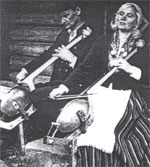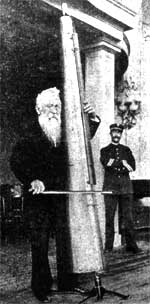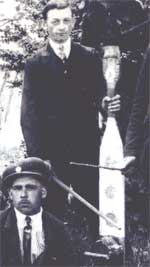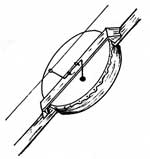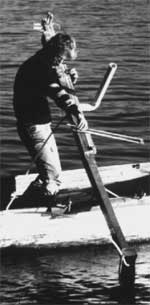 | |||||||
 |
the bumbass, lagerphone, and tromba marina connection. a short history of the one string stick |
|
|
A cursory glance through most music history books would give the preverbial alien from another planet the idea that music originated in Europe around 1100 AD, developed chronologically through half a dozen identifiable styles, and disintegrated into un-listenable complexity or mindless simplicity by the end of the 1960s. Alternatively, the hip contemporary music historian blurts out the artspeak version of the 20th century - Futurists, Duchamp, Cage, Fluxus, Musique Concrète, Minimalism, ending up in the sonic massage parlour with Brain Eno or worse (is there worse?). There are a few other linear pathways that may include jazz, rock or that trite piece of capitalism known as 'world music' - but the result will tend to be just as reductive as the accepted educational Ur-narrative. Luckily for the practice of music, musical instruments have often stepped outside the observed bounds of a movement or an aesthetic. And if you look closely at any -ism, it is often formed while embracing its nemesis. The clear lines of Modernism originated at the same time that Art Nouveau was wrapping its organic decoration around classic Greek columns. The functionalism of Bauhaus existed in parallel to the emotional expressionism of Kandinsky and Schoenberg. And in historical spitting distance of just these two examples, the bumbass was turned from a do-it-yourself folk instrument into an industrialized, manufactured noisemaker (Armin Voigt Musical Instrument Suppliers, Markneukirch, Germany, 1900-1929). The actual sound of the bumbass (with simulated drum roll) may have appealed to Filippo Marinetti and his fascist concept of noise, but its function in the people's music of the same period would not have fitted his political art aesthetic. Across the Atlantic, I'm sure Charles Ives would have added a bum bass to his Fourth Symphony if he had chanced upon the instrument. Meanwhile in Australia, it is still unclear if the lagerphone originated at the same time as the introduction of 'crown seal' beer bottle tops (1905) or morphed into existence as far back as the music halls of the 1840s. Sheer lack of interest by Australia's official cultural commentators means we will probably never know. It seems to me that the bumbass occupies some interesting middle ground, as its sonic function exists halfway between a string instrument (generally used as a pitch generator) and a percussion instrument (mostly used as a rhythm and noise generator). Indeed, the way in which a bumbass is traditionally played (with a serrated or notched stick used as double bass bow) points to an area of music making that became the happy hunting ground for many 'extended' instrumental techniques in the 20th century. The bumbass can be considered as a precursor to the whole story of serialism, which would eventually demand an integrated world for rhythm, timbre, and dynamics, as well as pitch in both structure and instrumental realization. Improvisers from time immemorial have intuitively known the logic of Klangfarbenmelodie, and today there exist many musos worldwide who incorporate all parameters of sound with every gesture. But again please consider - while Schoenberg worked on the seminal Pierrot Lunaire and earned his living writing material for the Berlin Cabaret, the bumbass was on the streets and in the parlour accompanying popular songs of the time. The bumbass is basically a stick, a string and some kind of resonator in the form of a pig's bladder, a gourd, a small drum, or a tin. A simpler string instrument there is not. Added to this basic format can be any amount of bells, whistles, gongs, rattles and cymbals. Technically, the bumbass requires independent dexterity. High levels of rhythmic counterpoint can be achieved with circular and spiccato col legno, bowing in the right hand while bouncing the body of the instrument on the floor with the left hand. * Tradition dictates the use of a wild carving at the top of the pole: a figurehead that literally or metaphorically pokes his tongue out at ordered society and its rulers. The bumbass comes to us from a long line of God's sidemen - men (for they were) with serious protagonistic clout that included the king's fool or jester, the jongleur, the anti-religious Feast of Fools, gothic gargoyles, and images of the devil himself. Australia might be the land of Featurism (Robin Boyd's damning indictment of the country's non-functional décor, architecture and general white bread aesthetic in his book The Australian Ugliness), but the lagerphone got a raw deal. Unlike the bumbass, lagerphones come without any visual titillation. Drink hard and play hard without distraction seemed to be the modus operandi. When my colleague and stroh violin enthusiast Aleks Kolkowski visited the Brussels Musical Instrument Museum last year, he asked to see the bumbass collection. The sticks and even the strings were available for show but the pig's bladders had, over time, become either a discrete pile of odourless dust or a mere stain on the woodwork. Such is the transient nature of bladder technology. A reference to the bumbass can be found in Jan Steen's painting 'The Serenaders' from the Golden Period of Dutch Art, the middle of the 17th century. From its nomenclature, we know that the bumbass was ubiquitous by that time. Here are a few slices off the bumbass cake - the Belgium basse de Flandre, the American stumpf fiddle, the Danish krigsdjaevel, the Austrian saubass, the English humstrum, the Polish luk muzycyny, the Spanish rabel. And with the rabel we reach back to the Moors of Spain and a time of Islamic enlightenment (the European Dark Ages!); we arrive at the common route of so many chordophones that became the mainstay of European culture. If we were to travel on another tack and link up with the Ottoman Empire (still in its last gasps at the beginning of the 20th century), we would find origins of the string-less lagerphone - the chaghana, named in the common racist tones of the time - the Turkish crescent, the Chinese (meaning anything not functioning correctly) pavilion, the jingling Johnny. And then we have to ask, where would Haydn (The 100th symphony known as the Military calls for a Turkish jingle) and Beethoven (last movement of the 9th Symphony) be without their 'Turkish percussion' to spike up their symphonies? Could it be that the lagerphone arrived back in Australia after the disgusting First World War waste of life known as the Gallipoli campaign? By turning the clock back to the last ice age, you can find the oldest rendition of a string instrument possibly anywhere. On a cave wall at Les Trois Freres in southwest France is a picture of a musical bow carbon-dated at 15,000 BC. This is arguably the Ur-string instrument fresh from the hunt. But if you go with evolutionary theory, the bow and arrow principle was probably an African import. It is certainly older than the first post-agricultural society of Sumer in Mesopotamia (now a salt desert), considered by many scholars to be the first 'civilization'. And on the civilization front, don't forget that Apollo was not only the Greek god of music but an archer as well. And on the theoretical front, an investigation of the bow wow origins of speech and music can be entertaining. The berimbau of Brazil is now appearing in exotic music shops worldwide and shows off enough cultural memes to judge it a runaway stick & string success story - it is almost synonymous with the 'world music' industry. Imported comparatively recently to the new world direct from West Africa via the slave trade in the seventeenth and eighteenth centuries, the berimbau can now be found in any CD shop near you. The berimbau utilizes a more reliable gourd for amplification instead of the bladder of the bumbass. Similar musical bows can be found used by the Shamans of Yurak and official witch doctors in New Guinea and the Solomons; there are many examples worldwide - too many to deal with in this short account. In India the government have named their main strike missile system the pinaka after the legendary musical bow of the god Shiva. As the blurb says, "the Pinaka is a multi-barrel rocket launcher Weapon Area System which can fire rockets with a range of 39-40 km, in a salvo of 12 rockets with 1.2 tons of high explosives within 40 seconds". Nice one. I think I prefer bows and arrows. In many cultures the musical bow (sound source) often morphed into the bowing bow (sound generator) and vice versa. European hegemony informs us that from such primitive beginnings eventually the violin bow emerges. Then the convex violin bows in use up to the 19th century are eventually rendered obsolete with the invention of the Tourte concave bow. The recent re-introduction of the Baroque convex bow into the now fashionable 'authentic early music' groups demonstrates just how wrong history books can get it. But what to do with all those mass produced Tourte bows? After all it was a fine invention - more spring, more tension, more flexibility, more sound. Why turn them back into musical bows of course! Over the years I've fitted a number of my ex-violin bows with high carbon steel wire for use in the interactive hyperstring project as musical bows. Back to Europe and I should mention Mihály and Gisela Halmágyi, the husband and wife team who were the last to play the folk music from the Gyimes locale in Rumania. Although Gisela's gardon (a three hairy stringed half cello/half log instrument) is unconnected to the bumbass, her wild beating of it (with stout stick) in compound rhythm sources a common thread to the bumbass and musical bow - resonating with a joyous thumping outcome. We're talking rumbling blood and guts here, something of the ancient origins of music - the sound of supplication and fear in a short and brutal existence. Where do we go instrumentally if we look for other one-string wonders in the European zone? Where else but the tromba marina? This instrument does sometimes get a mention in the official Ur-narrative, as it appears on monastery walls, aligning it more with God's side than the devil's part. There is also not much to be found chordophonically in church before the tromba marina (also known as the nun's delight **) makes its appearance. The inventors/developers of the tromba marina uncovered a sonic problem very similar to the electric guitar of the 20th century. In their virgin states, both instruments generate very pure, grainless sound. Superb as the natural harmonics of the tromba marina were, the musicians wanted more grain for their bow, just as the guitarists wanted, and still want, pedals to dirty up their squeaky clean sound. The solution was either to join a crusade and go beat up the Arabs or fit a drumming bridge to the tromba marina. The drumming bridge is a beaut piece of instrumental engineering. Observe an asymmetrical bridge with one foot supporting the string on the front plate, but the other foot going through the sound hole and not quite reaching the back plate - result? A serious buzzing, throbbing, drumming sound. Sorted. Then came the name that came up short on description, although I suspect the medieval imagination dealt with 'the sound of a drowning trumpet' with more ease than it handled a virgin birth. The tromba marina is an inspiration to all string instrument builders. The loop of history demanded that the notion of the drumming bridge be rediscovered in the 20th century where it was added, not to the electric guitar, but to the bumbass by means of a laterally vibrating wire mechanism. Shake, rattle and roll. In the antipodes the lagerphone was anyway a dry, stringless rattle. Want more rattle? Then drink more beer was the required option for a result of more resonance. Last year, while working on the pannikin project, I bought my first lagerphone in a Newtown shop in Sydney. 'Not some fake bullshit!' barked the guy at the counter, 'It's the real McCoy!'. * I'm reminded of that great news video when, in an effort to increase the African-American vote for the Republicans, Ronald and Nancy Reagan sat in on a Southern Baptist black church service. Completely unaware and musically inept, the Reagans were seen clapping along on 'one' and 'three'. Everyone else in the church of course was clapping on the required 'two' and 'four'. ** eh sorry I made that up - it was the nun's violin my thanks to Bart Hopkin's great resource, experimental musical instruments and famdt éditions for clues and pics in the preparation of this rave. |
 |


